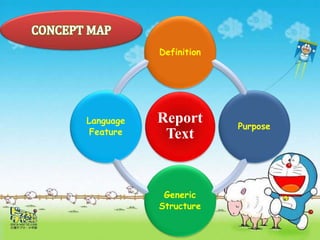Report text
Download as PPTX, PDF1 like214 views
1) The report text provides information about platypuses. It defines what a report text is and discusses the generic structure and language features of a report text. 2) Key details about platypuses are described, including that it is a semi-aquatic mammal found in eastern Australia and Tasmania, has a duck-like bill, webbed feet, and lays eggs despite being a mammal. 3) Female platypuses typically dig burrows in stream or river banks to protect themselves and their young, while males do not require burrows.
1 of 15
Downloaded 13 times















Recommended
REPORT TEXT



REPORT TEXTFelice Vallensia
Ã˝
We worked so hard to make this so please appreciate us! If you want to use this file, please don't forget to put the copyright. Thank you.Courtney



CourtneyNorthfield Community School
Ã˝
Frogs have four legs and hop around, eating many insects. They live at the bottom of lakes or ponds in mud or wetlands, sometimes sharing their habitat with other creatures. Frogs defend themselves by shooting out their long tongues at enemies like snakes and birds. Their young are called tadpoles. Frogs are helpful because they eat many bugs that could otherwise disturb humans or eat human food, with one frog capable of eating up to 1,000 small flies or 500 large flies.Jeopardy animals



Jeopardy animalsSONNYJM
Ã˝
This document contains a series of clues and answers about different types of animals. The clues are about birds, reptiles, amphibians, mammals, and fish. The answers identify specific animals like owls, turtles, frogs, deer, whales, and sharks.1.5 animal jeopardy



1.5 animal jeopardyEmily Hooker
Ã˝
1) The document is a quiz about different types of animals including birds, reptiles, amphibians, mammals, and fish.
2) It asks questions about the names of animal homes, body parts, behaviors, and species.
3) The questions are multiple choice where the reader must select the correct term that matches each description from a list of answer choices provided at the end.Collective Nouns



Collective NounsEva Rodríguez-Maestre
Ã˝
Collective nouns are names used to describe a group of animals, objects or people. The document lists examples of collective nouns for different animals like a pride of lions, a flock of geese, and a herd of elephants. It also asks the reader to identify the collective noun for a group of squirrels and provides more collective nouns like a pack of wolves, a pod of whales, and a swarm of bees.Factual Report



Factual ReportEvan Sanjaya
Ã˝
This factual report summarizes information about snakes. It begins with a general statement that snakes are carnivorous and found on every continent except Antarctica. Approximately 3000 snake species exist. The report then describes some unique physical attributes of snakes, such as their flexible jaws, lack of eyelids, and ability to swallow prey larger than their heads. It concludes by explaining that while some snakes use venom to hunt, pythons kill prey through constriction.B7c9cb89 cdcf-4ee4-9d0e-b6c51853d8ab



B7c9cb89 cdcf-4ee4-9d0e-b6c51853d8abmatea muñoz
Ã˝
This document provides information about classifying and comparing different types of animals, including vertebrates and invertebrates, mammals, birds, fish, reptiles, amphibians, insects, and other invertebrates. It includes tasks like matching animals to their classifications, labeling anatomy diagrams, completing statements about animal characteristics, and identifying true/false statements. The document aims to teach students about key distinguishing features of different animal phyla through various identification and matching exercises.Repoert teks for ix class semester 1



Repoert teks for ix class semester 1Faa Keeno
Ã˝
This document provides an introduction to report text structure and features. It begins with learning goals for identifying main ideas, finding information, and determining reference words in report texts. It then defines a report as presenting information through systematic observation and analysis. The document outlines the general structure of reports as including a general classification section and description section. It also lists language features of reports such as using general nouns, relating verbs, and the timeless present tense. An example report on kangaroos is provided that demonstrates these structures and features.Characteristics And Characteristics Of The Species



Characteristics And Characteristics Of The SpeciesMary Brown
Ã˝
The document provides information about two parasites: Toxoplasma gondii and Enterobius vermicularis. Both are classified as protists and parasites that derive nutrition from their hosts. While T. gondii infects many warm-blooded animals and causes the disease toxoplasmosis, E. vermicularis is commonly known as the pinworm and specifically infects humans, causing enterobiasis. A key difference is that T. gondii infects various tissues throughout the body, while E. vermicularis infects the gastrointestinal tract.Report



ReportReni Oktaviana
Ã˝
The platypus is a native animal of Tasmania and eastern Australia known for its duck-like bill. It has a flat tail, webbed feet, and thick fur-covered body that lives in streams and rivers. Female platypus typically dig burrows in riverbanks for protection from flooding, while males do not require burrows. The text analyzes the platypus's general classification and physical description, as well as its habitat and the language features used to describe it.Duck billed platypus



Duck billed platypusmohamed elebiary
Ã˝
The duck-billed platypus is a semiaquatic egg-laying mammal found in eastern Australia and Tasmania. It has a duck-like bill, webbed feet, a flat tail, and produces venom from ankle spurs. The platypus lays eggs and feeds its young milk through patches of skin. It lives in burrows near freshwater lakes and rivers, feeding on aquatic invertebrates and larvae. Though once hunted, the platypus is now a protected species.ANIMALS WITH BACKBONES.pptx



ANIMALS WITH BACKBONES.pptxBryanBangiban1
Ã˝
The document discusses the five main groups of vertebrates: mammals, birds, reptiles, amphibians, and fish. Mammals have hair and feed their young milk. Birds are covered in feathers and have wings. Reptiles have scaly skin and lungs. Amphibians spend part of their life on land and part in water. Fish live entirely in water and breathe through gills.Platypus



Platypusjabernethy
Ã˝
The platypus is a small semiaquatic mammal native to eastern Australia. It has the bill of a duck and tail of a beaver but also lays eggs. The platypus weighs between 700g to 2.3kg, is 5-15 inches long, and has brown fur and a leathery skin. It breathes through its nostrils, lays eggs, and its young are called muggles. The platypus is endangered due to a fungal infection.Biology m18 animals with backbones



Biology m18 animals with backbonesdionesioable
Ã˝
This module discusses animals with backbones, known as vertebrates. It covers five groups of vertebrates: fishes, amphibians, reptiles, birds, and mammals. The module is divided into lessons about the characteristics and examples for each group. Students are expected to learn to identify vertebrate characteristics and examples from each group, as well as their adaptations. The module provides diagrams, activities, and tests to help students meet the learning objectives.Biology m18 animals with backbones



Biology m18 animals with backbonesdionesioable
Ã˝
This module discusses animals with backbones, known as vertebrates. It covers five groups of vertebrates: fishes, amphibians, reptiles, birds and mammals. The module is divided into lessons about the characteristics and examples for each group. Students are expected to learn to identify the groups, their key adaptations, and distinguish among different types of mammals. The pre-test and lessons aim to help students achieve these learning objectives.Anatomy of vertebrate (basic biology) unm



Anatomy of vertebrate (basic biology) unmJeny Hardiah
Ã˝
This document summarizes a student's report on dissecting a frog to study vertebrate anatomy. It includes the student's name, class information, and confirmation that the report was accepted. The introduction provides background on frogs and discusses the life cycle and reproduction. The purpose of the practicum is stated as allowing students to observe the shape, color, and location of organs and their relationships. The benefits are learning vertebrate anatomy. The literature review discusses frog anatomy and systems to be examined. The methods section outlines that the dissection will take place in the biology lab, and lists the tools and process used, including anesthetizing the frog before external and internal examination.introduction of report text for junior high school



introduction of report text for junior high schoolaurajasminaqueena
Ã˝
The document is a report on standard competencies and basic competencies related to responding to and expressing meaning in monologue texts such as reports. It discusses understanding meaning in transactional and interpersonal conversations in everyday life as well as accurately, fluently and appropriately expressing meaning in monologues in the form of reports, narratives and analytical expositions in everyday life and accessing scientific knowledge. It also discusses responding to meaning in simple monologue texts using appropriate oral language forms and accurately, fluently and appropriately expressing meaning in report style monologue texts using appropriate oral language forms.Insects



InsectsNirbhay Pimple
Ã˝
A sneak view into the world of Insects. Classification , morphology, respiratory system, nervous system and metamorphosis.Kingdom animalia by louie



Kingdom animalia by louieMhark Leynes
Ã˝
The document describes the Kingdom Animalia and its classification. It discusses 9 phyla: Porifera, Coelenterata, Platyhelminths, Nematoda, Annelida, Arthropoda, Mollusca, Echinodermata, and Chordata. Each phylum is defined and examples are provided. The phylum Chordata is further divided into subphyla Protochordata and Vertebrata, with the five vertebrate classes of Pisces, Amphibia, Reptilia, Aves, and Mammalia described.Evaluunit 2



Evaluunit 2matea muñoz
Ã˝
This document provides information about classifying and identifying key characteristics of different animal groups, including:
- Vertebrates have backbones while invertebrates do not
- Mammals produce milk through mammary glands
- Herbivores eat plants, omnivores eat plants and animals, and carnivores eat only animals
- Birds do not have scales, and reptiles breathe through lungs and have dry, scaly skin and sometimes shells
- Fish have gills, fins, and scales and move through water
- Amphibians have moist skin and young breathe through gills while adults have lungs
- Arthropods include insects with six legs and three body parts, arachnids withAnimal Distinctions



Animal DistinctionsJay Newman
Ã˝
This document provides 10 distinctions between similar animals, including:
1) Alligators have wide U-shaped snouts while crocodiles have more pointed V-shaped snouts.
2) Centipedes have one pair of legs per body segment while millipedes have two pairs.
3) Horns are permanent projections covered in keratin while antlers are shed annually and made of bone.
4) Stray animals were once domesticated but now live wild, while feral animals were born wild from domesticated ancestors.Classification of Animals Biology 



Classification of Animals Biology Ammu Chandhini
Ã˝
There are two main categories of animals - vertebrates and invertebrates. Invertebrates do not have a backbone and include phyla such as sponges, jellyfish, flatworms, roundworms, segmented worms, arthropods, mollusks, and echinoderms. Vertebrates do have a backbone and are divided into five classes - fish, amphibians, reptiles, birds, and mammals. Tapeworms are flat, segmented parasitic worms that can live in the intestines of animals and be transmitted to humans by eating undercooked meat from infected animals.Animals



Animalsalesyas
Ã˝
This PowerPoint presentation for 1st grade introduces animal diversity by exploring where animals live and how they are alike and different. It discusses how animals can inhabit oceans, deserts, forests, the North Pole, and mountains. It then focuses on five animal groups - mammals, birds, insects, amphibians, and reptiles - describing their key distinguishing characteristics such as how mammals feed their young milk, birds have feathers and two feet, insects have three body parts and six legs, amphibians have smooth skin, and reptiles have rough dry skin.ANIMALS.pptx



ANIMALS.pptxsarbinaz1
Ã˝
This document provides an overview of different animal species from around the world. It begins by discussing the diversity of animal breeds and characteristics. It then examines key groups like mammals, birds, fish, and reptiles. Some specifics covered include mammals giving birth and nursing their young, while birds lay eggs. It also looks at predators that hunt other animals and herbivores that feed on plants. Finally, it profiles 10 unusual animal species, ranging from the poodle moth to the Japanese spider crab.Common pond hawk dragonfly/ ogie burrow presentation slideshare



Common pond hawk dragonfly/ ogie burrow presentation slideshareMarie Hostmom
Ã˝
Ogie burrow presentation slide share 2nd attempt
bio 123 574
Professor: zgeist
Bio 123 574
animal behavior.Seiton 



Seiton Candra Irawan
Ã˝
Seiton dalam 5s K3
5S adalah singkatan kata yang berasal dari bahasa Jepang yaitu: Seiri, Seiton, Seiso, Seiketsu dan Shitsuke.Kloning



KloningCandra Irawan
Ã˝
Kloning merupakan proses reproduksi aseksual yang menghasilkan individu baru yang identik secara genetik melalui rekayasa genetika, yang telah berhasil dilakukan pada domba bernama Dolly pada tahun 1997. Kloning memiliki berbagai manfaat, namun juga berpotensi menimbulkan risiko jika dilakukan secara tidak bertanggung jawab.More Related Content
Similar to Report text (20)
Characteristics And Characteristics Of The Species



Characteristics And Characteristics Of The SpeciesMary Brown
Ã˝
The document provides information about two parasites: Toxoplasma gondii and Enterobius vermicularis. Both are classified as protists and parasites that derive nutrition from their hosts. While T. gondii infects many warm-blooded animals and causes the disease toxoplasmosis, E. vermicularis is commonly known as the pinworm and specifically infects humans, causing enterobiasis. A key difference is that T. gondii infects various tissues throughout the body, while E. vermicularis infects the gastrointestinal tract.Report



ReportReni Oktaviana
Ã˝
The platypus is a native animal of Tasmania and eastern Australia known for its duck-like bill. It has a flat tail, webbed feet, and thick fur-covered body that lives in streams and rivers. Female platypus typically dig burrows in riverbanks for protection from flooding, while males do not require burrows. The text analyzes the platypus's general classification and physical description, as well as its habitat and the language features used to describe it.Duck billed platypus



Duck billed platypusmohamed elebiary
Ã˝
The duck-billed platypus is a semiaquatic egg-laying mammal found in eastern Australia and Tasmania. It has a duck-like bill, webbed feet, a flat tail, and produces venom from ankle spurs. The platypus lays eggs and feeds its young milk through patches of skin. It lives in burrows near freshwater lakes and rivers, feeding on aquatic invertebrates and larvae. Though once hunted, the platypus is now a protected species.ANIMALS WITH BACKBONES.pptx



ANIMALS WITH BACKBONES.pptxBryanBangiban1
Ã˝
The document discusses the five main groups of vertebrates: mammals, birds, reptiles, amphibians, and fish. Mammals have hair and feed their young milk. Birds are covered in feathers and have wings. Reptiles have scaly skin and lungs. Amphibians spend part of their life on land and part in water. Fish live entirely in water and breathe through gills.Platypus



Platypusjabernethy
Ã˝
The platypus is a small semiaquatic mammal native to eastern Australia. It has the bill of a duck and tail of a beaver but also lays eggs. The platypus weighs between 700g to 2.3kg, is 5-15 inches long, and has brown fur and a leathery skin. It breathes through its nostrils, lays eggs, and its young are called muggles. The platypus is endangered due to a fungal infection.Biology m18 animals with backbones



Biology m18 animals with backbonesdionesioable
Ã˝
This module discusses animals with backbones, known as vertebrates. It covers five groups of vertebrates: fishes, amphibians, reptiles, birds, and mammals. The module is divided into lessons about the characteristics and examples for each group. Students are expected to learn to identify vertebrate characteristics and examples from each group, as well as their adaptations. The module provides diagrams, activities, and tests to help students meet the learning objectives.Biology m18 animals with backbones



Biology m18 animals with backbonesdionesioable
Ã˝
This module discusses animals with backbones, known as vertebrates. It covers five groups of vertebrates: fishes, amphibians, reptiles, birds and mammals. The module is divided into lessons about the characteristics and examples for each group. Students are expected to learn to identify the groups, their key adaptations, and distinguish among different types of mammals. The pre-test and lessons aim to help students achieve these learning objectives.Anatomy of vertebrate (basic biology) unm



Anatomy of vertebrate (basic biology) unmJeny Hardiah
Ã˝
This document summarizes a student's report on dissecting a frog to study vertebrate anatomy. It includes the student's name, class information, and confirmation that the report was accepted. The introduction provides background on frogs and discusses the life cycle and reproduction. The purpose of the practicum is stated as allowing students to observe the shape, color, and location of organs and their relationships. The benefits are learning vertebrate anatomy. The literature review discusses frog anatomy and systems to be examined. The methods section outlines that the dissection will take place in the biology lab, and lists the tools and process used, including anesthetizing the frog before external and internal examination.introduction of report text for junior high school



introduction of report text for junior high schoolaurajasminaqueena
Ã˝
The document is a report on standard competencies and basic competencies related to responding to and expressing meaning in monologue texts such as reports. It discusses understanding meaning in transactional and interpersonal conversations in everyday life as well as accurately, fluently and appropriately expressing meaning in monologues in the form of reports, narratives and analytical expositions in everyday life and accessing scientific knowledge. It also discusses responding to meaning in simple monologue texts using appropriate oral language forms and accurately, fluently and appropriately expressing meaning in report style monologue texts using appropriate oral language forms.Insects



InsectsNirbhay Pimple
Ã˝
A sneak view into the world of Insects. Classification , morphology, respiratory system, nervous system and metamorphosis.Kingdom animalia by louie



Kingdom animalia by louieMhark Leynes
Ã˝
The document describes the Kingdom Animalia and its classification. It discusses 9 phyla: Porifera, Coelenterata, Platyhelminths, Nematoda, Annelida, Arthropoda, Mollusca, Echinodermata, and Chordata. Each phylum is defined and examples are provided. The phylum Chordata is further divided into subphyla Protochordata and Vertebrata, with the five vertebrate classes of Pisces, Amphibia, Reptilia, Aves, and Mammalia described.Evaluunit 2



Evaluunit 2matea muñoz
Ã˝
This document provides information about classifying and identifying key characteristics of different animal groups, including:
- Vertebrates have backbones while invertebrates do not
- Mammals produce milk through mammary glands
- Herbivores eat plants, omnivores eat plants and animals, and carnivores eat only animals
- Birds do not have scales, and reptiles breathe through lungs and have dry, scaly skin and sometimes shells
- Fish have gills, fins, and scales and move through water
- Amphibians have moist skin and young breathe through gills while adults have lungs
- Arthropods include insects with six legs and three body parts, arachnids withAnimal Distinctions



Animal DistinctionsJay Newman
Ã˝
This document provides 10 distinctions between similar animals, including:
1) Alligators have wide U-shaped snouts while crocodiles have more pointed V-shaped snouts.
2) Centipedes have one pair of legs per body segment while millipedes have two pairs.
3) Horns are permanent projections covered in keratin while antlers are shed annually and made of bone.
4) Stray animals were once domesticated but now live wild, while feral animals were born wild from domesticated ancestors.Classification of Animals Biology 



Classification of Animals Biology Ammu Chandhini
Ã˝
There are two main categories of animals - vertebrates and invertebrates. Invertebrates do not have a backbone and include phyla such as sponges, jellyfish, flatworms, roundworms, segmented worms, arthropods, mollusks, and echinoderms. Vertebrates do have a backbone and are divided into five classes - fish, amphibians, reptiles, birds, and mammals. Tapeworms are flat, segmented parasitic worms that can live in the intestines of animals and be transmitted to humans by eating undercooked meat from infected animals.Animals



Animalsalesyas
Ã˝
This PowerPoint presentation for 1st grade introduces animal diversity by exploring where animals live and how they are alike and different. It discusses how animals can inhabit oceans, deserts, forests, the North Pole, and mountains. It then focuses on five animal groups - mammals, birds, insects, amphibians, and reptiles - describing their key distinguishing characteristics such as how mammals feed their young milk, birds have feathers and two feet, insects have three body parts and six legs, amphibians have smooth skin, and reptiles have rough dry skin.ANIMALS.pptx



ANIMALS.pptxsarbinaz1
Ã˝
This document provides an overview of different animal species from around the world. It begins by discussing the diversity of animal breeds and characteristics. It then examines key groups like mammals, birds, fish, and reptiles. Some specifics covered include mammals giving birth and nursing their young, while birds lay eggs. It also looks at predators that hunt other animals and herbivores that feed on plants. Finally, it profiles 10 unusual animal species, ranging from the poodle moth to the Japanese spider crab.Common pond hawk dragonfly/ ogie burrow presentation slideshare



Common pond hawk dragonfly/ ogie burrow presentation slideshareMarie Hostmom
Ã˝
Ogie burrow presentation slide share 2nd attempt
bio 123 574
Professor: zgeist
Bio 123 574
animal behavior.More from Candra Irawan (7)
Seiton 



Seiton Candra Irawan
Ã˝
Seiton dalam 5s K3
5S adalah singkatan kata yang berasal dari bahasa Jepang yaitu: Seiri, Seiton, Seiso, Seiketsu dan Shitsuke.Kloning



KloningCandra Irawan
Ã˝
Kloning merupakan proses reproduksi aseksual yang menghasilkan individu baru yang identik secara genetik melalui rekayasa genetika, yang telah berhasil dilakukan pada domba bernama Dolly pada tahun 1997. Kloning memiliki berbagai manfaat, namun juga berpotensi menimbulkan risiko jika dilakukan secara tidak bertanggung jawab.Ayat ayat al quran tentang etos kerja



Ayat ayat al quran tentang etos kerjaCandra Irawan
Ã˝
1. Shalat Jumat dan meninggalkan urusan duniawi untuk mengingat Allah. Setelah shalat, bertebaran di muka bumi untuk mencari rezeki dari Allah sambil terus berdzikir kepada-Nya.
2. Ayat-ayat Alquran menekankan keseimbangan antara urusan dunia dan akhirat dalam bekerja, serta pentingnya selalu mengingat Allah dan produktivitas kerja tanpa menyerah.
3. Dokumen tersebut merangPerang Dunia II Dan Perang Dingin



Perang Dunia II Dan Perang DinginCandra Irawan
Ã˝
Perbedaan ideologi antara Amerika Serikat yang kapitalis liberal dan Uni Soviet yang sosialis komunis memicu perebutan dominasi setelah Perang Dunia II dan memulai Perang Dingin. Perang Dingin melibatkan persaingan di bidang politik, ekonomi, militer, dan angkasa antara kedua blok. Upaya-upaya dilakukan untuk mengurangi risiko perang nuklir melalui perjanjian-perjanjian pembatasan senjata.Pengaruh jejaring sosial terhadap remaja



Pengaruh jejaring sosial terhadap remajaCandra Irawan
Ã˝
Jejaring sosial memiliki dampak positif dan negatif bagi remaja. Dampak positifnya meliputi memperluas jaringan pertemanan secara global dan meningkatkan empati. Namun demikian, jejaring sosial juga dapat menyebabkan remaja menjadi malas berkomunikasi di dunia nyata dan berbahaya karena memungkinkan kejahatan siber. Upaya yang dapat dilakukan antara lain membatasi penggunaan jejaring sosial dan mengaAqidah dalam islam



Aqidah dalam islamCandra Irawan
Ã˝
Aqidah dalam Islam membahas berbagai aspek kepercayaan umat Islam seperti konsep tauhid, malaikat, hari kiamat, dan rasul. Dokumen ini juga menjelaskan tingkatan keimanan, fungsi aqidah, dan hubungan antara iman kepada Allah dan rasul dalam syahadat.Recently uploaded (20)
Helping Autistic Girls Shine Webinar ∫›∫›fl£s



Helping Autistic Girls Shine Webinar ∫›∫›fl£sPooky Knightsmith
Ã˝
For more information about my speaking and training work, visit: https://www.pookyknightsmith.com/speaking/Entity Framework Interview Questions PDF By ScholarHat



Entity Framework Interview Questions PDF By ScholarHatScholarhat
Ã˝
Entity Framework Interview Questions PDF By ScholarHatBlind spots in AI and Formulation Science, IFPAC 2025.pdf



Blind spots in AI and Formulation Science, IFPAC 2025.pdfAjaz Hussain
Ã˝
The intersection of AI and pharmaceutical formulation science highlights significant blind spots—systemic gaps in pharmaceutical development, regulatory oversight, quality assurance, and the ethical use of AI—that could jeopardize patient safety and undermine public trust. To move forward effectively, we must address these normalized blind spots, which may arise from outdated assumptions, errors, gaps in previous knowledge, and biases in language or regulatory inertia. This is essential to ensure that AI and formulation science are developed as tools for patient-centered and ethical healthcare.Administrative bodies( D and C Act, 1940



Administrative bodies( D and C Act, 1940P.N.DESHMUKH
Ã˝
These presentation include information about administrative bodies such as D.T.A.B
CDL AND DCC, etc.BISNIS BERKAH BERANGKAT KE MEKKAH ISTIKMAL SYARIAH



BISNIS BERKAH BERANGKAT KE MEKKAH ISTIKMAL SYARIAHcoacharyasetiyaki
Ã˝
BISNIS BERKAH BERANGKAT KE MEKKAH ISTIKMAL SYARIAHHannah Borhan and Pietro Gagliardi OECD present 'From classroom to community ...



Hannah Borhan and Pietro Gagliardi OECD present 'From classroom to community ...EduSkills OECD
Ã˝
Hannah Borhan, Research Assistant, OECD Education and Skills Directorate and Pietro Gagliardi, Policy Analyst, OECD Public Governance Directorate present at the OECD webinar 'From classroom to community engagement: Promoting active citizenship among young people" on 25 February 2025. You can find the recording of the webinar on the website https://oecdedutoday.com/webinars/
Comprehensive Guide to Antibiotics & Beta-Lactam Antibiotics.pptx



Comprehensive Guide to Antibiotics & Beta-Lactam Antibiotics.pptxSamruddhi Khonde
Ã˝
üì¢ Comprehensive Guide to Antibiotics & Beta-Lactam Antibiotics
üî¨ Antibiotics have revolutionized medicine, playing a crucial role in combating bacterial infections. Among them, Beta-Lactam antibiotics remain the most widely used class due to their effectiveness against Gram-positive and Gram-negative bacteria. This guide provides a detailed overview of their history, classification, chemical structures, mode of action, resistance mechanisms, SAR, and clinical applications.
üìå What You‚Äôll Learn in This Presentation
‚úÖ History & Evolution of Antibiotics
‚úÖ Cell Wall Structure of Gram-Positive & Gram-Negative Bacteria
‚úÖ Beta-Lactam Antibiotics: Classification & Subtypes
‚úÖ Penicillins, Cephalosporins, Carbapenems & Monobactams
‚úÖ Mode of Action (MOA) & Structure-Activity Relationship (SAR)
‚úÖ Beta-Lactamase Inhibitors & Resistance Mechanisms
‚úÖ Clinical Applications & Challenges.
üöÄ Why You Should Check This Out?
Essential for pharmacy, medical & life sciences students.
Provides insights into antibiotic resistance & pharmaceutical trends.
Useful for healthcare professionals & researchers in drug discovery.
üëâ Swipe through & explore the world of antibiotics today!
üîî Like, Share & Follow for more in-depth pharma insights!Dot NET Core Interview Questions PDF By ScholarHat



Dot NET Core Interview Questions PDF By ScholarHatScholarhat
Ã˝
Dot NET Core Interview Questions PDF By ScholarHatInventory Reporting in Odoo 17 - Odoo 17 Inventory App



Inventory Reporting in Odoo 17 - Odoo 17 Inventory AppCeline George
Ã˝
This slide will helps us to efficiently create detailed reports of different records defined in its modules, both analytical and quantitative, with Odoo 17 ERP.Azure Administrator Interview Questions By ScholarHat



Azure Administrator Interview Questions By ScholarHatScholarhat
Ã˝
Azure Administrator Interview Questions By ScholarHatMeeting the needs of modern students?, Selina McCoy



Meeting the needs of modern students?, Selina McCoyEconomic and Social Research Institute
Ã˝
NAPD Annual Symposium
“Equity in our Schools: Does the system deliver for all young people?”BỘ TEST KIỂM TRA GIỮA KÌ 2 - TIẾNG ANH 10,11,12 - CHUẨN FORM 2025 - GLOBAL SU...



BỘ TEST KIỂM TRA GIỮA KÌ 2 - TIẾNG ANH 10,11,12 - CHUẨN FORM 2025 - GLOBAL SU...Nguyen Thanh Tu Collection
Ã˝
https://app.box.com/s/ij1ty3vm7el9i4qfrr41o756xycbahmgHow to create security group category in Odoo 17



How to create security group category in Odoo 17Celine George
Ã˝
This slide will represent the creation of security group category in odoo 17. Security groups are essential for managing user access and permissions across different modules. Creating a security group category helps to organize related user groups and streamline permission settings within a specific module or functionality.Unit 1 Computer Hardware for Educational Computing.pptx



Unit 1 Computer Hardware for Educational Computing.pptxRomaSmart1
Ã˝
Computers have revolutionized various sectors, including education, by enhancing learning experiences and making information more accessible. This presentation, "Computer Hardware for Educational Computing," introduces the fundamental aspects of computers, including their definition, characteristics, classification, and significance in the educational domain. Understanding these concepts helps educators and students leverage technology for more effective learning.BỘ TEST KIỂM TRA GIỮA KÌ 2 - TIẾNG ANH 10,11,12 - CHUẨN FORM 2025 - GLOBAL SU...



BỘ TEST KIỂM TRA GIỮA KÌ 2 - TIẾNG ANH 10,11,12 - CHUẨN FORM 2025 - GLOBAL SU...Nguyen Thanh Tu Collection
Ã˝
Report text
- 1. Candra purnaIrawan(05) REPORT TEXT DiahAyuSavitri (08) Cutari Zsazsa Mahesa (07) CholidaUlfi (06) Presented by :
- 3. THE DEFINITION OF REPORT TEXT Report text is used to serves to provide information about an event or situation, after the investigation and through the multi consideration.
- 5. GENERIC STRUCTU RE General Classification • Stating classification of general aspect of thing; animal, public place, plant, etc which will be discussed in general. Description • Describing the thing which will be discussed in detail; part per part , customs or deed for living creature and usage for materials.
- 6. LANGUAGE FEATURE Use of general nouns e.g : “Hunting Dogs” not “My Dog” (specific) Use of action verbs e.g : jump, fly, run Use of timeless present e.g : often, always, usually Use of relating verbs or linking verbs e.g : seem, look, taste
- 8. The name "platypus" is often prefixed with the adjective "duck-billed" to form duck-billed platypus, despite there being only one species of platypus. Platypus is a mammal, although it has some different characteristic with other mammal. It gives births with laying her eggs, but it still has a pair of milk gland. Although possessing mammary glands, the platypus lacks teats. Instead, milk is released through pores in the skin. Platypus is a semiaquatic mammal endemic to eastern Australia, including Tasmania.Many people call platypus duckbill because this animal has a bill like duckbill. Platypus can also called as watermole or duckmole. General Classification Description
- 9. Platypus has a flat tail and webbed feet. Its weight varies considerably from 0.7 to 2.4 kg, with males being larger than females. Males average 50 cm in total length, while females average 43 cm. Its body covered with a thick, and woolly layer of fur. The platypus has an average body temperature of about 32°C (90°F) rather than the 37°C (99°F). Its bill is detecting prey and stirring up mud. Usually it ate crustaceans. Platypus' eyes and head are small. Its eyes contains double cones, which most mammals do not have. It has no ears but has ability to sense sound and lights. Platypus lives in streams, rivers, and lakes. Female platypus usually dig burrows in the streams or river banks. The burrows are blocked with soil to protect it from intruders and flooding. In the other hand, male platypus does not need any burrow to stay. Description
- 11. 1). What is the main idea of paragraph three? a. Platypus is called duckbill b. Platypus gives birth with laying their eggs c. Platypus’ bill is detecting prey and stirring up mud d. Platypus has different characteristic with other mammal e. Female platypus usually dig burrows in the stream,river,lakes Paragraf three : Platypus is a mammal, although it has some different characteristic with other mammal…….. Therefore the answer is d.
- 12. Memupuk Mengubur 2). What is the antonim of the word ‘dig’ in paragraph six? a. Take b. Burry c. Plant d. Close e. Fertilize = = = = = Mengambil Menutup Menanam menggali
- 13. 3). Why is Platypus different with other mammal ? a. Platypus can’t produce milk b. Platypus can swim in the water c. Platypus can breath with insane d. Platypus doesn’t have milk gland e. Platypus gives birth with laying their eggs Platypus is a mammal, although it has some different characteristic with other mammal. It gives births with laying her eggs,……(Paragraf three). Therefore the answer is e.
- 14. 4). Which statement is not true based on the text ? a. Platypus lives in the sea b. Platypus can be found in Tasmania c. Platypus has a flat tail and webbed feet d. Platypus gives births with laying her eggs e. The male platypus is larger than the female Paragraph 5 : Platypus lives in streams, rivers, and lakes. It says that Platypus doesn’t live in the sea. Therefore the answer is a. (Paragraph 1) (Paragraph 4) (Paragraph 3) (Paragraph 4)










